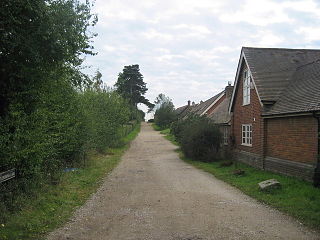See also
- Long Croft, a historic building in North Yorkshire, in England
Longcroft may refer to:

Beverley is a market town and civil parish in the East Riding of Yorkshire, England. It is located 27 miles (43 km) south-east of York and 9 miles (14 km) north-west of Hull. At the 2021 census the built-up area of the town had a population of 30,930, and the smaller civil parish had a population of 18,014. It is the county town of the East Riding of Yorkshire.

Havant is a town in the south-east corner of Hampshire, England, between Portsmouth and Chichester. Its borough comprises the town (45,826), the resort of Hayling Island, the town of Waterlooville, and the town of Emsworth. Housing and population more than doubled in the 20 years following World War II, a period of major conversion of land from agriculture and woodland to housing across the region following the incendiary bombing of Portsmouth and the Blitz.

Hanbury is a rural village in Worcestershire, England near Droitwich Spa and the M5 motorway. The population of Hanbury has remained around 1,000 since the early 19th century, and apart from farming and the popular Jinney Ring Craft Centre there is little economic activity, as the parish is lived in mainly by those who commute to the nearby towns of Bromsgrove, Redditch, Droitwich and Worcester, and the slightly more distant areas of Birmingham and the Black Country.

Coton is a village in Shropshire. It lies near the road from Whitchurch to Wem, about one mile southeast of Hollinwood.
"The Lincolnshire Poacher" is a traditional English folk song associated with the county of Lincolnshire, and deals with the joys of poaching. It is considered to be the unofficial county anthem of Lincolnshire. It is catalogued as Roud Folk Song Index No. 299.

Longcroft is a small village in the Falkirk council area in Scotland. The village is located 5.7 miles (9.2 km) west-southwest of Falkirk along a stretch of the A803 road between Haggs and Dennyloanhead. The main features of the village include the Masonic Arms pub and hotel.
Arthur Stuart, 7th Earl Castle Stewart, MC, styled Viscount Stuart from 1915 to 1921, was an Anglo-Irish peer and Unionist politician.

Dennyloanhead is a village in the Falkirk council area, Central Scotland, that is between Head of Muir and Longcroft. Dennyloanhead had a fingerpost announcing that it is 294 miles from John o' Groats. Old maps show it is 9 miles from Stirling and 5 miles from Falkirk.

Air Vice Marshal Sir Charles Alexander Holcombe Longcroft, was a pilot and squadron commander in the Royal Flying Corps who went on to become a senior commander in the Royal Air Force. He was the first commandant of the RAF College, Cranwell.

Hastoe is a hamlet in the civil parish of Tring. It is located in the Chiltern Hills, 1.7m south of the town of Tring in the county of Hertfordshire and on the county boundary with Buckinghamshire.
Yeovil Without is a civil parish in the South Somerset district of Somerset, England.
Okeover Butler Longcroft was an English first-class cricketer.
Longcroft School and Sixth Form College is a community secondary school situated in Molescroft, East Riding of Yorkshire, England. Its catchment area covers the north of Beverley, Leconfield, Swinemoor and Molescroft and has a capacity of around 1,500 pupils, including the Sixth Form.
Philip Bearcroft, D.D. was an English clergyman and antiquary.

Thomas Twining was an English merchant, and the founder of the tea merchant Twinings of London.

Longcroft is a small community in Cumbria, England, nestled in between Kirkbride and Anthorn. The village contains only five houses, one of which is Longcroft Farm, a dairy farm. The marsh at the bottom of the lands has been used in film documentaries, as it is the only place in Cumbria where there is not "background pollution".

Beverley Rugby Football Club is an English rugby union team based in Beverley, East Riding of Yorkshire. The club runs two senior men's sides, Colts, Ladies and a full set of junior teams. The first XV currently plays in Counties 1 Yorkshire.
Grasshoppers Football Club, sometimes known as Bonnybridge Grasshoppers, was a Scottish association football club based in Bonnybridge, Stirlingshire. The club was founded in 1875 and disbanded in 1901. The club was called Longcroft Thistle for a year in 1886–87 after relocating to the nearby village of Longcroft. The club competed in the Scottish Cup for periods between 1876 and 1890 and also the regional Stirlingshire Cup competition.
Okeover is an English surname. It may refer to:
Almondbury is a village and an unparished area in the metropolitan borough of Kirklees, West Yorkshire, England. Almondbury ward contains 118 listed buildings that are recorded in the National Heritage List for England. Of these, one is listed at Grade I, the highest of the three grades, four are at Grade II*, the middle grade, and the others are at Grade II, the lowest grade. The ward contains the village of Almondbury, the district of Moldgreen, and the surrounding area. Most of the listed buildings are houses and associated structures, cottages, farmhouses and farm buildings. Many of the houses were used in the domestic textile industry, and have long ranges of mullioned windows, especially in the upper storeys. The other listed buildings include a church and associated structures, a cross socket, textile mills, a mounting block, a public house, a police box, and a telephone kiosk.